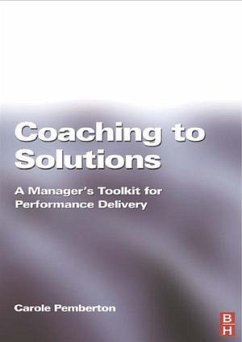Richard Barrett
Gebundenes Buch
The Values-Driven Organization
Cultural Health and Employee Well-Being as a Pathway to Sustainable Performance
Versandkostenfrei!
Versandfertig in 1-2 Wochen
Weitere Ausgaben:

PAYBACK Punkte
112 °P sammeln!





This book provides a compelling narrative about why values-driven organizations are the most successful organizations on the planet. According to Barrett, understanding employee's needs-what people value-is the key to creating a high performing organization. The text provides both a leadership approach and a language for organizational transformation and culture change that incorporates concepts such as cultural entropy, values alignment and whole system change.
Richard Barrett is an author, speaker and internationally recognised thought leader on the evolution of human values in business and society. He is the Founder and Chairman of the Barrett Values Centre, a Fellow of the World Business Academy and former Values Coordinator at the World Bank.
Produktdetails
- Verlag: Routledge
- 2. Auflage
- Seitenzahl: 306
- Erscheinungstermin: 1. Juni 2017
- Englisch
- Abmessung: 240mm x 161mm x 21mm
- Gewicht: 625g
- ISBN-13: 9781138679153
- ISBN-10: 1138679151
- Artikelnr.: 53305819
Herstellerkennzeichnung
Libri GmbH
Europaallee 1
36244 Bad Hersfeld
gpsr@libri.de
"I am immensely grateful to Richard Barrett and to his organization for my continued success, for changing my own philosophy of business and the way I approach change. In his new book, The Values-Driven Organization, Richard expands on his earlier work, and takes the opportunity to articulate why values are so important in shaping society and why they matter to humanity as a whole." -John McFarlane, Chairman, Barclays Bank
"Richard Barrett deserves his reputation as the leading expert on how values drive business success. His understanding of the interaction of the stages of psychological development with levels of human motivation is masterly. The insights contained in this book on how an organization can measure
"Richard Barrett deserves his reputation as the leading expert on how values drive business success. His understanding of the interaction of the stages of psychological development with levels of human motivation is masterly. The insights contained in this book on how an organization can measure
Mehr anzeigen
its culture and bring about change are intensely practical. The book provides a unique blend of theoretical foundation and useful advice for a leader of any type of organization." -Christopher Hodges, MA PhD FSALS, Professor of Justice Systems and Fellow of Wolfson College, University of Oxford
"Richard's grasp of conscious capitalism is extraordinary. In the second edition of his best-selling book The Values-Driven Organization he provides a process, methodology and tools for measuring the cultural health of organizations. I highly recommend this book if you believe caring for your employees comes before caring for your customers." -John Mackey, Co-Founder and Co-CEO, Whole Foods Market
"I have been applying the principles and practices Richard Barrett outlines in this book since 2010 with great results. The insights contained in this latest volume can help anyone become a more conscious leader of corporate culture." -Arvind Shankar, Global Managing Director, Accenture Enterprise Enablement
"In a world dominated by the power of money, the impact business has on our society is now greater than ever. By bringing empirical evidence and science to the otherwise elusive and qualitative measurements of what makes organizations thrive, Barrett provides the tools we need to measure and nurture the soul of an organization. The Values-Driven Organization maps the science of corporate soul retrieval." -Lawrence Ford, Author and CEO of Conscious Capital Wealth Management
"In The Values-Driven Organization, Richard Barrett, the world leading expert on values, offers an indispensable overview of how values function as the core operating principle for the human being and subsequently play a much more crucial role for individuals, organizations and societies than is generally understood." -Björn Larsson, CEO, ForeSight Group
"Richard Barrett never disappoints and this book is no exception. Every word is weighted with wisdom!" -Ann Dinan, PhD, Deeper Leadership Institute
"Richard Barrett's work has been a guiding light for much of the cultural change we have undertaken at CRU in the last few years. The intellectual rigour behind his work, demonstrated in the latest edition of Barrett's book, has been a key factor in our continued success." -Nick Morgan, CEO, CRU Group
"A superb read! If you are a CEO, Chief HR Officer, or Board member looking to transform your organization's culture, this is an essential read. Barrett provides the holistic, nuanced thinking you will need to guide your cultural transformation journey." -Penny Coates, Chief People and Culture Officer, Metcash Trading Limited
"Investors, regulators and organizations of all scales and sectors are increasingly demanding; The Values-Driven Organization draws from a wide range of sources and Richard's own experiences to provide practical insights and ideas that will be useful to anyone with an interest in cultural transformation." -Kevin Hills, EY Culture and Integrity Lead Partner, UK and Ireland
"After implementing the principles outlined in Richard's book The Values-Driven Organization, I have seen my organization excelling significantly in terms of employee engagement, passion and creativity, leading to new state-of-the-art business solutions and an outstanding performance. Richard's Full Spectrum Leadership approach has been a great catalyst in transforming the leadership team's view on the value of Employee Well-Being as a major energizing factor for the success and the sustainability of the organization." -Piet Lammens, General Manager, Statoil Coordination Center, Belgium
"What strikes me about this book is the way it manages to be both profound and practical in equal measures. In it Richard pinpoints with great wisdom the sources of, and barriers to, cultural health, and then provides clear guidance on how to improve it. The book is full of data, examples and case studies making it a very credible guide. I highly recommend to all change agents who invest their energy and care in making our organizations better institutions of human flourishing." -Liz Murphy, Old Mutual Group
"Attention trend-trackers! Richard Barrett has defined the cutting-edge of organizational values and culture for decades. Now in the second edition of his breakthrough best-seller The Values-Driven Organization, he reveals how employee well-being and a vibrant culture generate sustainable performance. A must read for leaders and HR professionals." -Patricia Aburdene, Author of Megatrends 2010 and Conscious Money
"At this turbulent juncture in human history, Richard Barrett helps us understand how we can develop more conscious leaders and organizations and provides us with a practical toolbox for facilitating individual and cultural transformation." -Tomas Björkman, Founder of Ekskäret Foundation, Stockholm, Sweden, and Author of The Market Myth
"Richard Barrett's latest book creates awareness and understanding about values and culture at an organizational as well as societal level. I hope many will find their way to this book and its important message. We are in need of its wisdom more than ever in these times of global challenge." -Patrik Andersson, CEO and Chairman Values Academy, Sweden
"The Values-Driven Organization is a must-read for any leader seeking to maximize efficacy in the workplace. Barrett's treatment of the dimensions of employee engagement as connected with organizational mission/values and personal development is spot on. For organizational leaders who truly want to improve the health of their organizations and retain the best employees, this book will serve as a treasured playbook." -Kenya Ayers, Vice President and Board Chair, Northwest Educational Council for Student Success (NECSS)
"In this admirably integrative book, Richard Barrett has brought together his own deep insights from years of leadership development research and organizational culture interventions with the latest quantitative and qualitative scholarship to craft a holistic model of values-driven organization. His model is unique not only for its integration of experience with research, but also its presentation of frameworks and metrics, as well as development tools, at the individual as well as the organizational levels. What's more, he positions this work within a larger societal and historical movement, providing a positive vision for the need and the opportunity presented by the millennial generation. The wisdom Barrett shares provides a vocabulary, a set of arguments and a compelling vision for individuals and organizations who wish to voice their values." -Mary C. Gentile, PhD, Author of Giving Voice to Values: How To Speak Your Mind When You Know What's Right and Creator/Director, Giving Voice To Values, University of Virginia Darden School of Business
"The ever-brilliant Richard Barrett has done it again. Bringing together decades of seminal work in understanding and elevating cultures, Richard has written a succinct yet comprehensive and practical guide to building, sustaining and leading values-driven organizations that enable the simultaneous flourishing of all their stakeholders. I know of no better framework or resource for personal and organizational growth and transformation. Richard has truly been a powerful force for spreading a more enlightened way of living, working and leading in the world. Bravo!" -Raj Sisodia, Co-Founder and Co-Chairman, Conscious Capitalism Inc., FW Olin Distinguished Professor of Global Business, Babson College
"Reading the book is a three-fold journey of exploration for yourself, the immediate team you lead and your organization. The book unfolds obvious and subtle truths of the connection between human, organization, the world, and values. Having worked with an organization with values at its core, I couldn't agree more with Mr Barrett and his expression. A must read for transitioning yourself and your organization from ego to soul." -Niels Caszo, Global President, AIESEC, a youth leadership movement
"As a strong believer in values-driven organizations, I have found the work and research of the Barrett Values Centre to be the most compelling in making the link between values-driven leadership and high performance. The frameworks, tools and case studies that Barrett provides have helped our organization tremendously on its path of transformation." -Wendy van Tol, PwC Partner Consulting, PricewaterhouseCoopers Advisory N.V.
"Richard's grasp of conscious capitalism is extraordinary. In the second edition of his best-selling book The Values-Driven Organization he provides a process, methodology and tools for measuring the cultural health of organizations. I highly recommend this book if you believe caring for your employees comes before caring for your customers." -John Mackey, Co-Founder and Co-CEO, Whole Foods Market
"I have been applying the principles and practices Richard Barrett outlines in this book since 2010 with great results. The insights contained in this latest volume can help anyone become a more conscious leader of corporate culture." -Arvind Shankar, Global Managing Director, Accenture Enterprise Enablement
"In a world dominated by the power of money, the impact business has on our society is now greater than ever. By bringing empirical evidence and science to the otherwise elusive and qualitative measurements of what makes organizations thrive, Barrett provides the tools we need to measure and nurture the soul of an organization. The Values-Driven Organization maps the science of corporate soul retrieval." -Lawrence Ford, Author and CEO of Conscious Capital Wealth Management
"In The Values-Driven Organization, Richard Barrett, the world leading expert on values, offers an indispensable overview of how values function as the core operating principle for the human being and subsequently play a much more crucial role for individuals, organizations and societies than is generally understood." -Björn Larsson, CEO, ForeSight Group
"Richard Barrett never disappoints and this book is no exception. Every word is weighted with wisdom!" -Ann Dinan, PhD, Deeper Leadership Institute
"Richard Barrett's work has been a guiding light for much of the cultural change we have undertaken at CRU in the last few years. The intellectual rigour behind his work, demonstrated in the latest edition of Barrett's book, has been a key factor in our continued success." -Nick Morgan, CEO, CRU Group
"A superb read! If you are a CEO, Chief HR Officer, or Board member looking to transform your organization's culture, this is an essential read. Barrett provides the holistic, nuanced thinking you will need to guide your cultural transformation journey." -Penny Coates, Chief People and Culture Officer, Metcash Trading Limited
"Investors, regulators and organizations of all scales and sectors are increasingly demanding; The Values-Driven Organization draws from a wide range of sources and Richard's own experiences to provide practical insights and ideas that will be useful to anyone with an interest in cultural transformation." -Kevin Hills, EY Culture and Integrity Lead Partner, UK and Ireland
"After implementing the principles outlined in Richard's book The Values-Driven Organization, I have seen my organization excelling significantly in terms of employee engagement, passion and creativity, leading to new state-of-the-art business solutions and an outstanding performance. Richard's Full Spectrum Leadership approach has been a great catalyst in transforming the leadership team's view on the value of Employee Well-Being as a major energizing factor for the success and the sustainability of the organization." -Piet Lammens, General Manager, Statoil Coordination Center, Belgium
"What strikes me about this book is the way it manages to be both profound and practical in equal measures. In it Richard pinpoints with great wisdom the sources of, and barriers to, cultural health, and then provides clear guidance on how to improve it. The book is full of data, examples and case studies making it a very credible guide. I highly recommend to all change agents who invest their energy and care in making our organizations better institutions of human flourishing." -Liz Murphy, Old Mutual Group
"Attention trend-trackers! Richard Barrett has defined the cutting-edge of organizational values and culture for decades. Now in the second edition of his breakthrough best-seller The Values-Driven Organization, he reveals how employee well-being and a vibrant culture generate sustainable performance. A must read for leaders and HR professionals." -Patricia Aburdene, Author of Megatrends 2010 and Conscious Money
"At this turbulent juncture in human history, Richard Barrett helps us understand how we can develop more conscious leaders and organizations and provides us with a practical toolbox for facilitating individual and cultural transformation." -Tomas Björkman, Founder of Ekskäret Foundation, Stockholm, Sweden, and Author of The Market Myth
"Richard Barrett's latest book creates awareness and understanding about values and culture at an organizational as well as societal level. I hope many will find their way to this book and its important message. We are in need of its wisdom more than ever in these times of global challenge." -Patrik Andersson, CEO and Chairman Values Academy, Sweden
"The Values-Driven Organization is a must-read for any leader seeking to maximize efficacy in the workplace. Barrett's treatment of the dimensions of employee engagement as connected with organizational mission/values and personal development is spot on. For organizational leaders who truly want to improve the health of their organizations and retain the best employees, this book will serve as a treasured playbook." -Kenya Ayers, Vice President and Board Chair, Northwest Educational Council for Student Success (NECSS)
"In this admirably integrative book, Richard Barrett has brought together his own deep insights from years of leadership development research and organizational culture interventions with the latest quantitative and qualitative scholarship to craft a holistic model of values-driven organization. His model is unique not only for its integration of experience with research, but also its presentation of frameworks and metrics, as well as development tools, at the individual as well as the organizational levels. What's more, he positions this work within a larger societal and historical movement, providing a positive vision for the need and the opportunity presented by the millennial generation. The wisdom Barrett shares provides a vocabulary, a set of arguments and a compelling vision for individuals and organizations who wish to voice their values." -Mary C. Gentile, PhD, Author of Giving Voice to Values: How To Speak Your Mind When You Know What's Right and Creator/Director, Giving Voice To Values, University of Virginia Darden School of Business
"The ever-brilliant Richard Barrett has done it again. Bringing together decades of seminal work in understanding and elevating cultures, Richard has written a succinct yet comprehensive and practical guide to building, sustaining and leading values-driven organizations that enable the simultaneous flourishing of all their stakeholders. I know of no better framework or resource for personal and organizational growth and transformation. Richard has truly been a powerful force for spreading a more enlightened way of living, working and leading in the world. Bravo!" -Raj Sisodia, Co-Founder and Co-Chairman, Conscious Capitalism Inc., FW Olin Distinguished Professor of Global Business, Babson College
"Reading the book is a three-fold journey of exploration for yourself, the immediate team you lead and your organization. The book unfolds obvious and subtle truths of the connection between human, organization, the world, and values. Having worked with an organization with values at its core, I couldn't agree more with Mr Barrett and his expression. A must read for transitioning yourself and your organization from ego to soul." -Niels Caszo, Global President, AIESEC, a youth leadership movement
"As a strong believer in values-driven organizations, I have found the work and research of the Barrett Values Centre to be the most compelling in making the link between values-driven leadership and high performance. The frameworks, tools and case studies that Barrett provides have helped our organization tremendously on its path of transformation." -Wendy van Tol, PwC Partner Consulting, PricewaterhouseCoopers Advisory N.V.
Schließen
Für dieses Produkt wurde noch keine Bewertung abgegeben. Wir würden uns sehr freuen, wenn du die erste Bewertung schreibst!
Eine Bewertung schreiben
Eine Bewertung schreiben
Andere Kunden interessierten sich für













